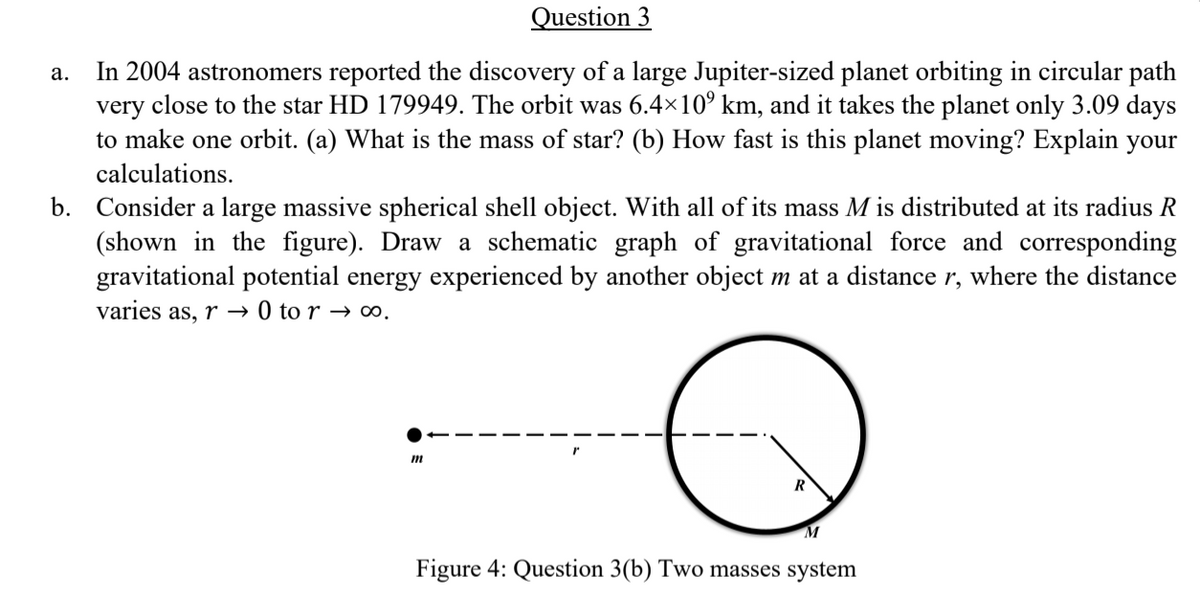Question 3 In 2004 astronomers reported the discovery of a large Jupiter-sized planet orbiting in circular path very close to the star HD 179949. The orbit was 6.4×10° km, and it takes the planet only 3.09 days to make one orbit. (a) What is the mass of star? (b) How fast is this planet moving? Explain your calculations. а.
Question 3 In 2004 astronomers reported the discovery of a large Jupiter-sized planet orbiting in circular path very close to the star HD 179949. The orbit was 6.4×10° km, and it takes the planet only 3.09 days to make one orbit. (a) What is the mass of star? (b) How fast is this planet moving? Explain your calculations. а.
Physics for Scientists and Engineers: Foundations and Connections
1st Edition
ISBN:9781133939146
Author:Katz, Debora M.
Publisher:Katz, Debora M.
Chapter7: Gravity
Section: Chapter Questions
Problem 3PQ: For many years, astronomer Percival Lowell searched for a Planet X that might explain some of the...
Related questions
Question
Please mention all theory parts.

Transcribed Image Text:Question 3
In 2004 astronomers reported the discovery of a large Jupiter-sized planet orbiting in circular path
very close to the star HD 179949. The orbit was 6.4×10° km, and it takes the planet only 3.09 days
to make one orbit. (a) What is the mass of star? (b) How fast is this planet moving? Explain your
а.
calculations.
b. Consider a large massive spherical shell object. With all of its mass M is distributed at its radius R
(shown in the figure). Draw a schematic graph of gravitational force and corresponding
gravitational potential energy experienced by another object m at a distance r, where the distance
varies as, r → 0 to r → ∞.
R
M
Figure 4: Question 3(b) Two masses system
Expert Solution
This question has been solved!
Explore an expertly crafted, step-by-step solution for a thorough understanding of key concepts.
This is a popular solution!
Trending now
This is a popular solution!
Step by step
Solved in 3 steps with 3 images

Knowledge Booster
Learn more about
Need a deep-dive on the concept behind this application? Look no further. Learn more about this topic, physics and related others by exploring similar questions and additional content below.Recommended textbooks for you

Physics for Scientists and Engineers: Foundations…
Physics
ISBN:
9781133939146
Author:
Katz, Debora M.
Publisher:
Cengage Learning

University Physics Volume 1
Physics
ISBN:
9781938168277
Author:
William Moebs, Samuel J. Ling, Jeff Sanny
Publisher:
OpenStax - Rice University

Principles of Physics: A Calculus-Based Text
Physics
ISBN:
9781133104261
Author:
Raymond A. Serway, John W. Jewett
Publisher:
Cengage Learning

Physics for Scientists and Engineers: Foundations…
Physics
ISBN:
9781133939146
Author:
Katz, Debora M.
Publisher:
Cengage Learning

University Physics Volume 1
Physics
ISBN:
9781938168277
Author:
William Moebs, Samuel J. Ling, Jeff Sanny
Publisher:
OpenStax - Rice University

Principles of Physics: A Calculus-Based Text
Physics
ISBN:
9781133104261
Author:
Raymond A. Serway, John W. Jewett
Publisher:
Cengage Learning

Classical Dynamics of Particles and Systems
Physics
ISBN:
9780534408961
Author:
Stephen T. Thornton, Jerry B. Marion
Publisher:
Cengage Learning

College Physics
Physics
ISBN:
9781938168000
Author:
Paul Peter Urone, Roger Hinrichs
Publisher:
OpenStax College

Glencoe Physics: Principles and Problems, Student…
Physics
ISBN:
9780078807213
Author:
Paul W. Zitzewitz
Publisher:
Glencoe/McGraw-Hill